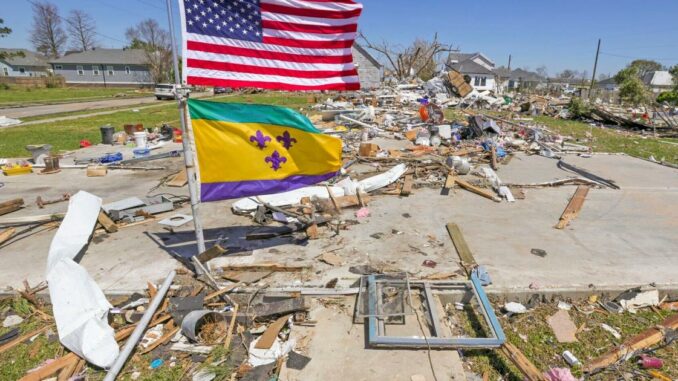
Ashley and others said although the Mississippi tornado fits the projected pattern, it was a single weather event, which is different than climate projections over many years and a large area.
Ashley and study co-author Victor Gensini, another meteorology professor at Northern Illinois University and a longtime tornado expert, said they are watching the potential for another supercell blow-up in the Mid-South on Friday.
Destroyed and damaged homes on Rose and Benjamin streets in Arabi, La. Wednesday, March 23, 2022, after an EF 3 tornado ripped through the neighborhood Tuesday night. (Photo by David Grunfeld, NOLA.com | The Times-Picayune) ORG XMIT: BAT2203231539290130
Past studies have been unable to forecast supercells and tornadoes in future climate simulations because they are small-scale events, especially tornadoes, that global computer models can’t see. Ashley and Gensini used smaller regional computer models and compensated for their reduced computing power by spending two years running simulations and crunching data.
Three scientists not connected to the study said it makes sense. One of them, Pennsylvania State University tornado scientist Paul Markowski, called it a promising advance because it explicitly simulated storms, compared to past research that only looked at general environments favorable to supercells.
While the study finds a general increase in supercell counts, what it mostly finds are large shifts in where and when they hit — generally, more east of Interstate 35, which runs through east central Texas, Oklahoma and Kansas, and fewer to the west.
In moderate warming – less warming than the world is headed for based on current emissions – parts of eastern Mississippi and eastern Oklahoma are projected to get three more supercells every two years, with eastern Texas, Arkansas, Louisiana, Alabama, western Tennessee and eastern Georgia getting one more supercell every other year.
With worst-case warming — more than the world is presently on track for — the study projects similar changes but with worsening supercells over eastern Oklahoma, Arkansas and southern Missouri.
Cities that should see more supercells as warming worsens include Dallas-Fort Worth, Little Rock, Memphis, Jackson, Tupelo, Birmingham and Nashville, Ashley said.

Leave a Reply